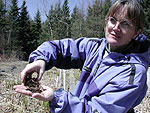By Stephanie Hemphill
Minnesota Public Radio
July 10, 2002
Northeastern Minnesota has some special challenges when it comes to handling human waste. Health officials say most of the septic systems in St. Louis County don't function properly. Now, people are beginning to experiment with new kinds of septic systems that might work better than the traditional trench system.
| |
|
|
|
||
Not everyone lives on a sewer line. People who aren't served by a city sewer system need to treat the waste from their toilets, showers, and washing machines right where they live. Nearly a third of the homes in Minnesota have septic systems in their backyards.
Conventional septic setups start with a tank, where solids settle to the bottom and get pumped out every few years. The liquid flows to a leaching field, where it percolates through soil. Organisms in the soil absorb pathogens, and the wastewater is supposed to be clean by the time it reaches the groundwater.
The trouble is, in many places in notheastern Minnesota, there's hardly any soil. You often stand on bedrock. What soil there is tends to be heavy clay. It doesn't soak up water well. And because the area is rich in lakes and rivers, the groundwater can be just a few inches below the surface.
Researchers at the Natural Resources Research Institute are testing several experimental systems.
The NRRI's Barb McCarthy says a modular peat filter, self-contained in a plastic tub about the size of a refrigerator, can clean up the wastewater generated by one or two people. She says peat is very good at removing pathogens in the waste.
"We think that is because of the biological community that you find in a peat filter, it's probably dominated more by the fungi and those types of organisms."
McCarthy says the filters work so well, they've seen everything from worms to frogs living in the peat filters at the experiment station.
| |
|
|
|
||
Dan Karban installed a peat system when he built a house on Wild Rice Lake north of Duluth.
Karban says he decided against a traditional septic system.
"All I heard was they might work, they might not work," Karban says. "They were really subject to fail. And I didn't want that. So I was willing to spend the extra money to get something that I felt was going to not only last longer but also look more appealing on our landsite here."
The tubs of peat are buried in the ground. As the water works its way through the peat filter, the organisms clean it up. Then it's pumped to a leaching field, which looks just like the rest of the yard.
Karban paid about twice as much for the peat system as he would have for a traditional system, but he's delighted with the way it's practically invisible in his yard. And it even warns him, with beepers and lights, when he's got a problem.
He recalls a rainy spring. "We had alarms going off everywhere, because the leaching field was so saturated with water that it wasn't taking anymore water," Karban says. "It was telling the pumps not to pump anymore water. So we needed to cut back on our water usage."
In a traditional septic system, there would be no audible warning - your nose would tell you when the trenches were too full.
| |
|
|
|
||
More and more Minnesotans are deciding to live at the lake instead of just visiting on weekends. At Grand Lake north of Duluth, people have converted a lot of cabins to year-round homes. Their sewage was feeding the algae in the lake. It was turning green.
Gene Curnow and his neighbors were worried. "If you want to keep your lake," he says, "we found out from the other lakes around here that the overload is just too much and everything blooms in the summer. The lake becomes un-useable in the nicest months of the year."
The neighbors got together and built a wetland to handle their wastewater.
Each house has a tank for the solids. Pumps send the liquids to the wetland, built away from the lake. Bacteria among the roots of the plants break down the pathogens in the water. Curnow says the lake has been cleaner since they built the wetland.
"The nutrients are not getting into the lake like they were," Curnow says. "And that's what this does, it brings the nutrients out here and lets the plants eat them."
People in Scandanavia have been treating their household sewage with constructed wetlands and peat filters for years. But Minnesota rules aren't set up to permit them. The counties in northeastern Minnesota are working on changing the rules.



